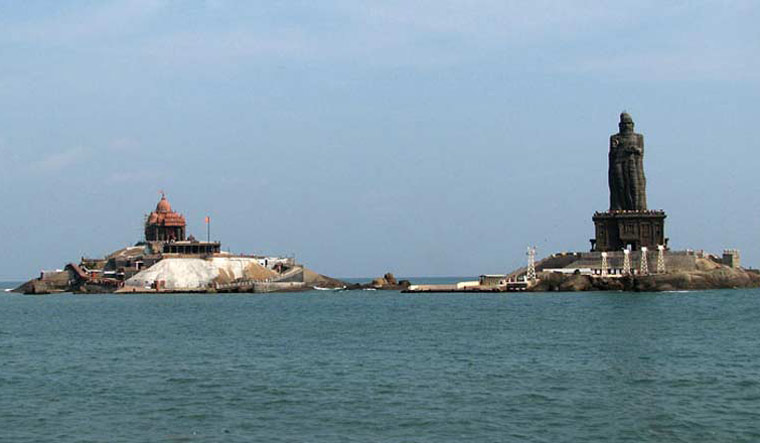One of the magnificent traditional architectural work of modern India is the Rock Memorial of Swami Vivekananda. The memorial marks its fiftieth anniversary on 2nd September 2020. In India, there are thousands of monuments but there is hardly any such memorial that is bustling and full of life. The “Vivekananda Rock Memorial”, was dedicated to the nation in the year 1970, is one such memorial that keeps Vivekananda’s ideas and teachings alive.
After two years of long travel across the sacred land of Bharat Swami Vivekananda reached Kanyakumari and after performing a “sadhana” at the rock (present day Vivekananda Rock Memorial ) situated at Kanyakumari, the southern most tip of India on 25-27 December 1892, Swamiji began his work for the revival of India . It is the same stone situated at the confluence of three seas, where “Shripad” of Mata Kanyakumari still exists. The memorial has been constructed by the Rashtriya Swayamsevak Sangh(RSS) pracharak Honourable Eknath Ranadeji, who brought the memorial to life by establishing the “Vivekananda Kendra” – A spiritually oriented service Mission in 1972.
In 1963, the birth centenary of Swamiji was celebrated all over the country. On this occasion, the local people of Kanyakumari formed a committee to build a memorial on that historic rock. Due to obstacles at various levels, that committee approached the then RSS Sarsanghchalak , Shri Madhav Sadashiv Golwalkar ji, who entrusted the responsibility to Eknathji. While on one hand, Tamil Nadu Chief Minister M. Bhaktavatsalam categorically refused to approval of any construction on the rock and on the other, Humayun Kabir, the Union Minister for Cultural Affairs, created hurdles by saying “the monument on the rock will spoil the natural beauty”. But with his efficient management, patience and purity, Eknathji kept the issue public, he met various leaders and personalities in Delhi and apprised them of the subject at various levels by keeping it away from politics.
Eknathji raised Members of Parliament (MPs) of various political parties from their individual political differences to “Bharatiyata” and in three days reached the then Home Minister Shri Lal Bahadur Shastriji with the signature of 323 MPs. When such a large number of MPs expressed their desire to build a memorial, the message was clear that the entire country is in favour of the memorial, Congress or socialist, communist or Dravidian leader all agreed in unison.
Permission secured but where will the money come from? Eknathji sought cooperation from each and every province ranging from Chief Minister of Jammu and Kashmir Sheikh Abdullah to Hokishe Sema of Nagaland. When he met Communist leader Jyoti Basu the then Deputy Chief Minister of West Bengal, he said, “It appears to me that you couldn’t have come to meet this Jyoti Basu because I have nothing to do with Vivekananda“. Eknathji said, “How can I believe that you have nothing to do with Swamiji?” Didn’t he raise his voice for the downtrodden? You are also the benefactors of the downtrodden, he was also the defender of the oppressed, and you are also their defender. Jyoti Basu said, “Yes, from this point of view, I admire him because he was the representative of oppressed and downtrodden but he expressed his inability due to his membership of Communist Party.” Eknathji connected Mrs. Kamala Basu (Jyoti Basu’s wife) with the work. Her contribution to the memorial was 1100 rupees through her friends and relatives. By doing so, Eknathji got various ideologies to enter the “confluence of “Bharatiyata”.
Irrespective of the party in power, almost all the state governments donated Rs. 1 lakh each. The first donation of Rs 10,000 for the memorial was made by Swami Chinmayananda of “Chinmaya Mission” to the Vivekananda Rock Memorial Committee. To connect the society with the memorial, nearly 30 lakh people gave contributions in the denomination of Rupees 1, 2 and 5 . About one per cent of the adult population at that time participated in it. Swami Vireshwarananda, President of Ramakrishna Math and Mission consecrated Vivekananda Rock Memorial and it was formally inaugurated on 2nd September 1970 by Shri V. V. Giri, President of India. The inauguration ceremony lasted for about 2 months and the Prime Minister of India, Smt. Indira Gandhi also attended.
“Vivekananda Kendra – a spiritually oriented service organization” was established on 7 January 1972 to give life to the memorial. Thousands of volunteers of Vivekananda Kendra conduct activities in the tribal and rural areas like education and natural resource development, cultural research, publications, youth engagement programme “sanskar” classes and yoga classes for all.
This is the Golden Jubilee year of this monument, which is in true sense a national memorial, a memorial for which all MP’s irrespective of their political affiliations appealed, for a memorial for which people donated all over the country, the only memorial for which almost all state governments donated minimum one lakh rupees each . Celebrating its 50th year Vivekananda Kendra initiated the “Ek Bharat Vijayi Bharat” connectivity campaign by meeting the President and Prime Minister of India ,through this connectivity campaign the volunteers of Vivekananda Kendra will contact thousands of people from different sections of the society and inspire them by “giving the message of Swami Vivekananda as well as motivating them to contribute for the welfare and promotion of the society.”
This article was written by Nikhil Yadav. He is a State Youth Head at Vivekananda Kendra, Uttar Prant. He obtained his Masters in History from University Of Delhi and is pursuing COP in Vedic Culture from Jawaharlal Nehru University.
